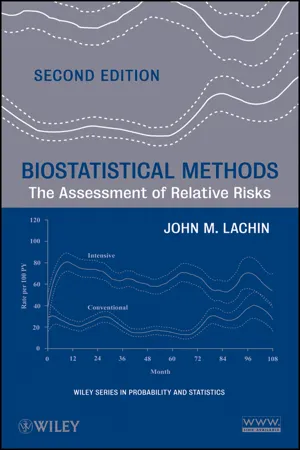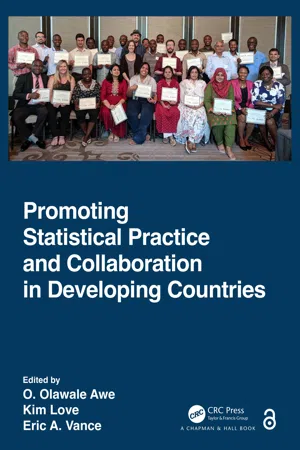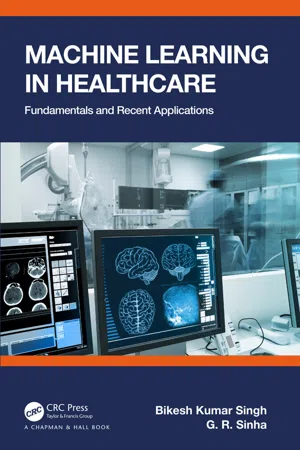Biological Sciences
Health Statistics
Health statistics refer to numerical data and information related to various aspects of health, including disease prevalence, mortality rates, and healthcare utilization. These statistics are used to analyze and understand patterns of health and illness within populations, inform public health policies and interventions, and evaluate the effectiveness of healthcare systems and programs.
Written by Perlego with AI-assistance
Related key terms
4 Key excerpts on "Health Statistics"
- eBook - ePub
Biostatistical Methods
The Assessment of Relative Risks
- John M. Lachin(Author)
- 2014(Publication Date)
- Wiley(Publisher)
biostatistics refers to the development of statistical methods for, and the application of statistical principles to, the study of biological and medical phenomena.Biomedical research activities range from the study of cellular biology to clinical therapeutics. At the basic physical level it includes bench research , the study of genetic, biochemical, physiological, and biological processes, such as the study of genetic defects, metabolic pathways, kinetic models, and pharmacology. Although some studies in this realm involve investigation in animals and humans (in vivo ), many of these investigations are conducted in “test tubes” (in vitro ). The ultimate objective of these inquiries is to advance our understanding of the pathobiology or pathophysiology of human diseases and of the potential mechanisms for their treatment.Clinical research refers to direct observation of the clinical features of populations. This includes epidemiology , which can be broadly defined as the study of the distribution and etiology of human disease. Some elements, such as infectious disease epidemiology, are strongly biologically based, whereas others are more heavily dependent on empirical observations within populations. The latter include such areas as occupational and environmental epidemiology, the study of the associations between occupational and environmental exposures with the risk of specific diseases. This type of epidemiology is often characterized as population based because it relies on the observation of natural samples from populations.Ultimately, bench research or epidemiologic observation leads to advances in medical therapeutics: the development of new pharmaceuticals (drugs), devices, surgical procedures, or interventions. Such therapeutic advances are often assessed using a randomized, controlled clinical trial. Such studies evaluate the biological effectiveness of the new agent (biological efficacy), the clinical effectiveness of the therapy in practice (the intention-to-treat - O. Olawale Awe, Kim Love, Eric A. Vance, O. Olawale Awe, Kim Love, Eric A. Vance(Authors)
- 2022(Publication Date)
- Chapman and Hall/CRC(Publisher)
Scientific research generates huge amounts of data that have to be analyzed and interpreted to provide insights that will shape intelligent decisions. Biostatistics plays a vital role in this process. A few applications are summarized below:- In pharmaceuticals: Biostatisticians help to design clinical trials and to measure the efficacy of treatments and drugs. Biostatisticians are not only engaged in clinical trials but also help in observational and complex interventional studies using statistical models for prediction and extrapolation.
- In public health: Health-care professionals deal with numerous biological systems that contain inherent variability, and biostatisticians develop statistical tools and methods necessary to draw reasonably accurate inferences, despite the uncertainty inherent in the biological systems (Matthews and Farewell 1996 ). These inferences are used to improve the quality of public health and to advance evidence-based healthcare.
- In epidemiology: Various factors influence the cause, outbreak, and distribution of a disease. Epidemiological studies aim to identify these factors by collecting various data related to the disease and deriving the link between the cause and the effect. Biostatistics is vital in understanding certain epidemiological principles such as incidence, prevalence, odds, risk ratio, and number needed to treat (Luscombe et al. 2001 ). The Center for Disease Control reports that “Epidemiology is the basic science of public health and therefore uses statistics to reach conclusions about diseases within certain population groups” (Hosmer et al. 2013 ).
- In medical sciences: Biostatistics is the science that helps to manage medical uncertainties. A sound knowledge of biostatistics is important for medical and nursing students, so that they can design epidemiological studies accurately and draw meaningful conclusions. An important aspect of a doctor’s job is to understand and condense the provided data, analyze findings, and engage in research activities. An important tool for all these tasks is biostatistics ! Biostatistics is a branch of applied statistics, and it must be taught with a focus on its various applications in biomedical research (Indrayan and Malhotra 2017
- eBook - ePub
Machine Learning in Healthcare
Fundamentals and Recent Applications
- Bikesh Kumar Singh, G.R. Sinha(Authors)
- 2022(Publication Date)
- CRC Press(Publisher)
1 BiostatisticsDOI: 10.1201/9781003097808-1Learning Objectives
This chapter aims to cover:- Importance of biostatistics
- Description of the most important biostatistics used in analysis and classification of biomedical and medical applications
- The role of statistics in mathematical modelling
In the last decade, interest in mathematical modelling and analysis of underlying phenomena in the diverse field of biology have significantly grown. This includes the design of experiments and the formulation of the research hypothesis, sources of biological and medical data, data collection methods, analysis, and interpretation and evaluation procedures. The broad field which encompasses all these steps is termed biostatistics. Biostatistics deals with development of statistical techniques for analysing data associated to living organisms. The purpose of this chapter is to present an overview of fundamental concepts in biostatistics and its application in health research.1.1 Data and Variables
Data includes variables, observations or measurements obtained from elements of the population. “The population” means the group considered for study, for example, someone who wants to study possible risk factors that may lead to cancer in the future. In this situation, the study population will comprise cancer patients and the risk factors will be measurements recorded from these patients. Data or the collection of data is sometimes also referred to as a database. There are several ways of categorizing data, and the data can be qualitative or quantitative, discrete or continuous, nominal or ordinal and so on. Let’s understand these concepts with some examples.Consider the female breast cancer risk prediction problem using certain variables such as dietary habits (vegetarian/non-vegetarian), smoking habits (yes/no), waist size, hip size, waist-hip ratio (WHR), socio-economic status (low, middle, high), body mass index, number of children and number of abortions. Here, variables such as dietary habits, smoking habits and socio-economic status are qualitative variables as these cannot be expressed as a number, while other variables, namely age, waist size, hip size, waist-hip ratio (WHR), body mass index and routine blood pathology measures are quantitative as these variables can be represented as numbers. Quantitative variables can be further classified into continuous or discrete, and continuous variables can take any numeric value, and discrete variables can take only a finite number of values. For example, waist size, hip size, waist-hip ratio (WHR) are continuous variables, while variables such as number of children and number of abortions are discrete. The third category, is the nominal or ordinal subcategory of qualitative variables. The variables dietary habits and smoking habits are nominal variables as these variables are not ordered. On the other hand, variables such as socio-economic status, which can be ordered in series or sequence, are called ordinal. - eBook - ePub
- Peter Armitage, Geoffrey Berry, J. N. S. Matthews(Authors)
- 2013(Publication Date)
- Wiley-Blackwell(Publisher)
19
Statistical methods in epidemiology
19.1 Introduction
The branch of medical science called epidemiology has been defined as ‘the study of the distribution and determinants of health-related states or events in specified populations, and the application of this study to control of health problems’ (Last, 1995, p. 55). In broad terms epidemiology is concerned with the distribution of disease, or of a physiological condition, and of the factors that influence the distribution. It includes within its orbit the study of chronic diseases, as well as the communicable diseases which give rise to epidemics of the classical sort. The subject overlaps to some extent with social medicine, community medicine or public health , which would usually be understood to include social and administrative topics, such as the provision and use of health services.Epidemiology is concerned with certain characteristics of groups of individuals rather than single subjects, and inevitably gives rise to statistical problems. Many of these are conceptually similar to statistical problems arising in other branches of medical science, and, indeed, in the non-medical sciences, and can be approached by the methods of analysis described earlier in this book; several examples in earlier chapters have been drawn from epidemiological studies. Other methodological problems in epidemiology, although of statistical interest, are bound up with considerations of a non-statistical nature and cannot be discussed here. Examples are the interpretation of vital and health statistical data, which requires a close knowledge of administrative procedures for the recording of such data and of the classification of diseases and causes of death (Benjamin, 1968; World Health Organization, 1992); and the proper use and potential development of medical records of various sorts (Acheson, 1967). There is also a considerable body of literature concerned with the mathematical theory of epidemic disease; the monographs by Bailey (1975) and Becker (1989) provide useful summaries of this work. For general accounts of epidemiological methods, the reader may consult Kleinbaum et al . (1982), Miettinen (1985), Hennekens et al . (1987), Elwood (1988), Kelsey et al
Learn about this page
Index pages curate the most relevant extracts from our library of academic textbooks. They’ve been created using an in-house natural language model (NLM), each adding context and meaning to key research topics.



